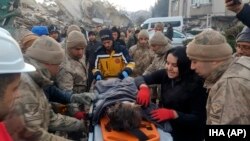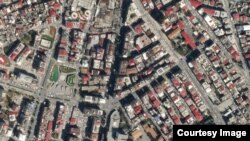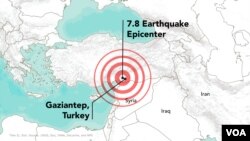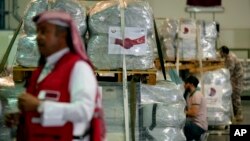Rescue crews in Turkey and Syria raced against time and the cold Wednesday to find survivors buried in the rubble of buildings toppled by powerful earthquakes that struck the region Monday and left more than 11,000 people dead.
The rescue effort in Turkey involved 96,000 personnel, the country’s emergency management agency said Wednesday.
Search sites have been the scenes of some celebrations as people are found alive and taken away for medical care. But uncovering the rubble has also meant frequent increases in the number of casualties.
Officials in Turkey said at least 8,574 people were killed and more than 38,000 others were injured. In Syria, there were at least 2,530 deaths, according to figures from the Damascus government and rescue groups.
The earthquake is now the world’s deadliest seismic event since a 2011 earthquake and tsunami that killed nearly 20,000 people in Japan.
The epicenter of Monday’s pre-dawn earthquake was in Pazarcik, near the city of Gaziantep, close to the Turkey-Syria border. Turkish President Recep Tayyip Erdogan visited the area Wednesday, including a stop at a tent city in Kahramanmaras that the emergency management agency set up for people affected by the earthquake.
Erdogan declared seven days of national mourning and a three-month state of emergency in 10 provinces directly affected by the quake.
Erdogan described the earthquake as “unique in the world,” and he thanked Qatar for offering 10,000 container homes for people left homeless.
Search teams and emergency aid from throughout the world poured into Turkey and Syria as rescue workers dug through the rubble in a desperate search for survivors. Some voices that had been crying out for help fell silent.
"We could hear their voices, they were calling for help," said Ali Silo, whose two relatives could not be saved in the Turkish town of Nurdagi.
More than 8,000 people have been pulled from the debris in Turkey alone, Vice President Fuat Oktay said, and some 380,000 have taken refuge in government shelters or hotels. They huddled in shopping malls, stadiums, mosques and community centers, while others spent the night outside wrapped in blankets gathering around fires.
The earthquake struck a region enveloped on both sides of the border by more than a decade of civil war in Syria. On the Syrian side, the swath affected is divided between government-held territory and the country’s last opposition-held enclave, which is surrounded by Russian-backed government forces. Turkey, meanwhile, is home to millions of refugees from the conflict.
‘A crisis on top of a crisis’
The U.N. resident coordinator for Syria said Wednesday that 10.9 million people have been affected across the country by the earthquake. Before the quake, there were already 15.3 million in need of humanitarian assistance in the country, due to more than a decade of civil war.
“So, it’s a crisis on top of a crisis,” El-Mostafa Benlamlih told reporters at the United Nations in New York during a video briefing from Damascus.
He said in Aleppo alone, they estimate a third of homes have been damaged or destroyed, displacing around 100,000 people.
Humanitarians are coping with a shortage of fuel for their operations, as well as freezing temperatures and damaged roads and infrastructure.
The World Food Program has pre-positioned food stocks in the area, which Benlamlih said are enough to feed 100,000 people for one week. The World Health Organization has two planes with medical supplies coming from its hub in Dubai to Damascus. But more supplies need to come in urgently.
Additionally, the main road the United Nations uses to get aid from Gaziantep in Turkey to the transshipment point into northwest Syria was damaged in the quake and closed.
“So we couldn’t send any relief items; we were looking for alternative routes,” Muhannad Hadi, U.N. regional humanitarian coordinator for Syria, told reporters from Amman, Jordan. He said they had word Wednesday that the road is opening, and they could start delivering some supplies as early as Thursday.
The U.N. has access to only one crossing point from Turkey into Syria. With their aid partners they move between 500 to 600 supply trucks monthly across the border into areas beyond government control in northwest Syria.
The Damascus government prefers all aid go through the capital and has said earthquake response assistance should also go through them. The U.N. says moving aid across conflict frontlines is more complex and in 2022, there were just nine such convoys. So far this year, there was one in January. Humanitarians say the two kinds of operations -- cross border and crossline – should complement each other.
Meanwhile, the U.N. announced a $25 million grant on Tuesday to help invigorate the humanitarian response in both Syria and Turkey. Benlamlih said U.N. humanitarian chief Martin Griffiths would be arriving in the region in a couple of days. Damage assessment teams are also arriving to do thorough needs assessments.
The World Food Program appealed Wednesday for $46 million to provide food assistance to a half-million people in Turkey and Syria for the next 3-4 months.
Turkey is in one of the world’s most active earthquake zones.
In 1999, more than 17,000 people were killed when a 7.4 magnitude earthquake — the worst to hit Turkey in decades — struck near Duzce, in the northwest of the country.
Last October, a magnitude 7.0 quake hit the Aegean Sea, killing 116 people and injuring more than 1,000. All but two of the victims were in Izmir.
Margaret Besheer contributed to this report. Some material for this article came from The Associated Press, Agence France-Presse and Reuters.










